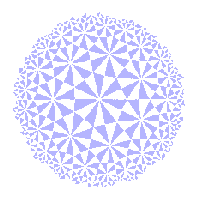
 |
The Klein View of Geometry |
|
If we take E(2) and S(2) in matrix form, then we have the inclusions E(2) ≤ S(2) ≤ A(2). (see the affine group page). Then, the geometries are related in the manner indicated by Theorems K1 and K2. There, we noted that, in euclidean geometry, the congruence class containing the circle C0 = {(x,y) : x2 + y2 = 1} consists of all circles of radius 1. In similarity geometry, it consists of all circles, a union of euclidean classes. In affine geometry, it consists of all ellipses, a yet larger class. On the other hand, the set of lines is a single congruence class in each geometry, so not every class grows if we enlarge the group. Also, euclidean geometry has the peoperty of length of segments, similarity geometry has the property of ratio of lengths of segements, while affine has only the ratio of lengths of parallel segments. But all three geometries have the concept of betweenness.
|
|
|
There are relations between other groups we have met, but these are not so simple as inclusion. Looking at them reveals some of the more subtle aspects of Klein's definitions. In the inversive group page, we met
The ∞ Theorem
There, S(2) was obtained by extending elements of S(2) to E+. As an example, we can give another proof of
The Fundamental Theorem of Similarity Geometry
Alternative Proof
Likewise, the congruence classes are related. In inversive geometry, other examples
|
|